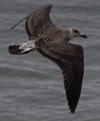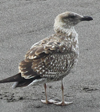 Atlantic Yellow-legged Gull (atlantis)
Atlantic Yellow-legged Gull (atlantis)
(last update: October 12, 2011)
Atlantic YLG 1cy July - September
data from: Malling Olsen, K. & Larsson, H. 2004 Gulls of Europe, Asia and North America. London: Christopher Helm.
here we continue with juvenile plumage:
Juvenile (Azores) closer to Lesser Black-backed Gull than to michahellis, as plumage is dark chocolate-brown. Head and underbody with dense dark streaks or spots; often rather uniform brownish, recalling American Herring. Saddle chocolate-brown with pale feather fringes (Azores/ Madeira). In Canary Islands sometimes paler with more chequered pale spotting along edges. Upperwing rather uniform dark, at most with faint pale window on inner primaries (a larger proportion in Madeira / Canary Islands have paler inner primaries). Greater coverts blackish with slight pale barring or waving near tips to all greater coverts (more obvious than in michahellis, similar to American Herring). Tertials similar to michahellis: dark with white to sandy edges and tips, often irregular near tip (where sometimes narrow, dark ‘extra’ bar). Often pale spot near bend of uppering. Underwing-coverts dark brown, occasionally with gingery tinge; darker and more uniform than in michahellis and Herring; close to some Lesser Blackbacks, American Herring and Kelp Gulls, but sometimes paler-barred. Tail and rump similar to Lesser Blackback; tail with broad dark bar, covering 55-80 mm on T1. T6 usually with white, dark-spotted outer web, grading into paler base (rarely as dark as in American Herring); sometimes closer to Herring nominate argentatus and Yellow-legged. 1-2 mm white tips to rectrices. Rump and uppertail-coverts more strongly dark-barred than in michahellis, again often similar to American Herring. Dark streaks or spots on head, body and underparts extensive into first-winter; usually has whitish forehead, throat and lower belly. Breast-sides to flanks often dark greyish-brown, sometimes reduced to spotting. Undertail-coverts white with dark V-markings, often crossing the whole of each feather (unlike typical michahellis); in others only along edges as in most michahellis. Eye dark but may already become paler in first-winter. Bill black with 0-5 mm pale tip. Legs fleshy, many with darker spotting on upper tarsus and on feet (Dubois 2001) – a character unknown in other W Palaearctic gulls (but frequent in Kelp Gull).
[Note: the complete text above is from Malling Olsen & Larsson, including this last sentence about leg colour. However, a word of caution is needed: (almost?) all gull species in the Western Palearctic in fresh juvenile plumage have dark on the shins. In some species these dark patches turn paler with age, and e.g. michahellis Yellow-legged Gull may show very pale salmon-pink shins after 1CY November. This may then serve as possible field mark when compared to graellsii Lesser Black-backed Gulls which normally have the dark shins well into March-April the next year. In short: this last sentence is not correct, and in fact a mis-quote of Dubois, in his 2011 article in BW, where he stated: All the juveniles I checked on the Azores and on the Canary Islands showed extensive dark markings on the front of the tarsi and on the feet. ]uveniles and first-winters in Madeira apparently show a similar pattern (S. Nicolle, pers. com.). Nominate michahellis juveniles may show such dark markings less commonly, and they seem to be more quickly lost in other species such as Herring Gull and Lesser Black-backed Gull. Interestingly, this feature occurs on Kelp Gull L. dominicanus too (Higgins & Davies 1996). The bill is black. See for Dubois' text: HERE.]
First winter Similar to juvenile. Many seem to retain most of juvenile plumage in winter, moulting directly into second-winter. Some attain new brownish-grey mantle / scapulars in late summer. Wing strongly worn from Febr / Mar.
 Atlantic YLG (atlantis) 1cy, September 17 2012, Povoacao, Azores Islands. Picture: Chris van Rijswijk.
Atlantic YLG (atlantis) 1cy, September 17 2012, Povoacao, Azores Islands. Picture: Chris van Rijswijk. Atlantic YLG (atlantis) 1cy, September 17 2012, Povoacao, Azores Islands. Picture: Chris van Rijswijk.
Atlantic YLG (atlantis) 1cy, September 17 2012, Povoacao, Azores Islands. Picture: Chris van Rijswijk. Atlantic YLG (atlantis) 1cy, September 01 2010, São Miguel, Azores Islands. Picture: Richard Lowe.
Atlantic YLG (atlantis) 1cy, September 01 2010, São Miguel, Azores Islands. Picture: Richard Lowe.  Atlantic YLG (atlantis) 1cy, September 01 2010, São Miguel, Azores Islands. Picture: Richard Lowe.
Atlantic YLG (atlantis) 1cy, September 01 2010, São Miguel, Azores Islands. Picture: Richard Lowe.  Atlantic YLG (atlantis) 1cy, September 01 2010, São Miguel, Azores Islands. Picture: Richard Lowe.
Atlantic YLG (atlantis) 1cy, September 01 2010, São Miguel, Azores Islands. Picture: Richard Lowe.  Atlantic YLG (atlantis) 1cy, September 01 2010, São Miguel, Azores Islands. Picture: Richard Lowe.
Atlantic YLG (atlantis) 1cy, September 01 2010, São Miguel, Azores Islands. Picture: Richard Lowe.  Atlantic YLG (atlantis) 1cy, September 2009, Azores Islands. Picture: Peter Alfrey.
Atlantic YLG (atlantis) 1cy, September 2009, Azores Islands. Picture: Peter Alfrey. Atlantic YLG (atlantis) 1cy, September 2009, Azores Islands. Picture: Peter Alfrey.
Atlantic YLG (atlantis) 1cy, September 2009, Azores Islands. Picture: Peter Alfrey. Atlantic YLG (atlantis) 1cy, September 01 2010, São Miguel, Azores Islands. Picture: Richard Lowe.
Atlantic YLG (atlantis) 1cy, September 01 2010, São Miguel, Azores Islands. Picture: Richard Lowe.  Atlantic YLG (atlantis) 1cy, September 2009, Azores Islands. Picture: Peter Alfrey.
Atlantic YLG (atlantis) 1cy, September 2009, Azores Islands. Picture: Peter Alfrey. Atlantic YLG (atlantis) 1cy, September 2009, Azores Islands. Picture: Peter Alfrey.
Atlantic YLG (atlantis) 1cy, September 2009, Azores Islands. Picture: Peter Alfrey. Atlantic YLG (atlantis) 1cy, September 01 2010, São Miguel, Azores Islands. Picture: Richard Lowe.
Atlantic YLG (atlantis) 1cy, September 01 2010, São Miguel, Azores Islands. Picture: Richard Lowe.  Atlantic YLG (atlantis) 1cy, September 01 2010, São Miguel, Azores Islands. Picture: Richard Lowe.
Atlantic YLG (atlantis) 1cy, September 01 2010, São Miguel, Azores Islands. Picture: Richard Lowe.  Atlantic YLG (atlantis) 1cy,
September 17 2012, Praia da Rib Grande - São Miguel, Azores Islands. Picture: António Gonçalves.
Atlantic YLG (atlantis) 1cy,
September 17 2012, Praia da Rib Grande - São Miguel, Azores Islands. Picture: António Gonçalves. Atlantic YLG (atlantis) 1cy, September 17 2012, Praia da Rib Grande - São Miguel, Azores Islands. Picture: António Gonçalves.
Atlantic YLG (atlantis) 1cy, September 17 2012, Praia da Rib Grande - São Miguel, Azores Islands. Picture: António Gonçalves. Atlantic YLG (atlantis) 1cy,
September 17 2012, Praia da Rib Grande - São Miguel, Azores Islands. Picture: António Gonçalves.
Atlantic YLG (atlantis) 1cy,
September 17 2012, Praia da Rib Grande - São Miguel, Azores Islands. Picture: António Gonçalves.